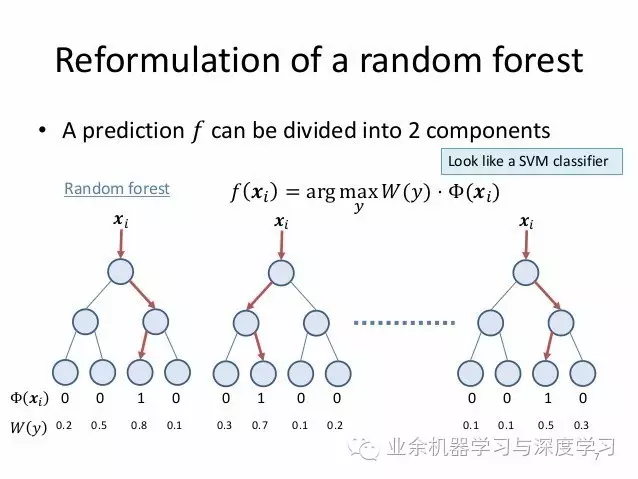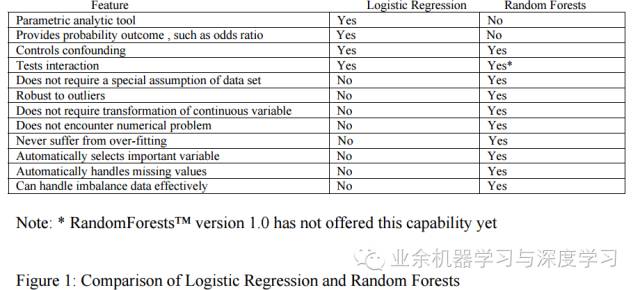
紧接上文,本文谈谈随机森林。
随机森林是由多个决策树集成得到的。它是一种比较成功地机器学习算法,不仅可以用于分类问题,也可以用于回归问题。随机森林通过结合多个决策树来降低过拟合的风险。随机森林可以捕捉到非线性特征,也可以学到特征的交互作用。
spark.mllib 中的随机森林支持二分类和多分类以及回归问题,其中包含连续特征和离散特征,spark.mllib中随机森林的实现是基于决策树来实现的。
基本算法
随机森林中的每个决策树独立训练,因此训练过程可以并行实现。算法的训练过程中加入了随机性,所以每个决策树都略有不同。将每个决策树的预测结果合并之后可以降低预测的方差,并且可以提高在测试集上的效果。
训练过程
训练过程中的随机性包括:
除了上述随机性,决策树的训练过程跟一般的决策树训练方式相同。
预测过程
对于一个新样本,为了对其进行预测,随机森林需要集成每个决策树的预测结果。分类和预测问题中,随机森林的集成策略是不同的。
分类问题:多数投票策略。每个决策树的预测结果看作对该类的投票,哪个类得票最多,样本就被分为哪一类。
回归问题:取均值。每个决策树都给出一个实数值。最终预测结果是所有决策树预测结果的均值。.
使用建议
使用决策树的过程中存在若干需要注意的参数。
前两个是最重要的参数,调节这两个参数通常可以提高性能:
numTrees:随机森林中决策树的个数
maxDepth: 森林中每棵树的深度
下面两个参数通常不需调节,但是,调节这两个参数可以加速训练过程。
示例
分类
下面的示例给出了如何加载 LIBSVM data file, 并将其解析为RDD格式的 LabeledPoint,然后利用随机森林来分类。其中的测试误差用来衡量算法的准确率。
Scala示例如下
AP细节可以参考 RandomForest Scala docs 和 RandomForestModel Scala docs
import org.apache.spark.mllib.tree.RandomForest
import org.apache.spark.mllib.tree.model.RandomForestModel
import org.apache.spark.mllib.util.MLUtils
// Load and parse the data file.
val data = MLUtils.loadLibSVMFile(sc, "data/mllib/sample_libsvm_data.txt")
// Split the data into training and test sets (30% held out for testing)
val splits = data.randomSplit(Array(0.7, 0.3))
val (trainingData, testData) = (splits(0), splits(1))
// Train a RandomForest model.
// Empty categoricalFeaturesInfo indicates all features are continuous.
val numClasses = 2
val categoricalFeaturesInfo = Map[Int, Int]()
val numTrees = 3 // Use more in practice.
val featureSubsetStrategy = "auto" // Let the algorithm choose.
val impurity = "gini"
val maxDepth = 4
val maxBins = 32
val model = RandomForest.trainClassifier(trainingData, numClasses, categoricalFeaturesInfo, numTrees, featureSubsetStrategy, impurity, maxDepth, maxBins)
// Evaluate model on test instances and compute test error
val labelAndPreds = testData.map { point =>
val prediction = model.predict(point.features)
(point.label, prediction)}
val testErr = labelAndPreds.filter(r => r._1 != r._2).count.toDouble / testData.count()
println("Test Error = " + testErr)
println("Learned classification forest model:\n" + model.toDebugString)
// Save and load model
model.save(sc, "target/tmp/myRandomForestClassificationModel")
val sameModel = RandomForestModel.load(sc, "target/tmp/myRandomForestClassificationModel")
Spark Repo中的"examples/src/main/scala/org/apache/spark/examples/mllib/RandomForestClassificationExample.scala" 给出了完整示例代码。
回归
本例给出了如何加载 LIBSVM data file, 并将其解析成 RDD 格式的 LabeledPoint, 然后利用随机森林进行回归。均方误差 Mean Squared Error (MSE) 用来衡量拟合的效果。
Scala示例如下
API 细节参考 RandomForest Scala docs 和 RandomForestModel Scala docs
import org.apache.spark.mllib.tree.RandomForest
import org.apache.spark.mllib.tree.model.RandomForestModel
import org.apache.spark.mllib.util.MLUtils
// Load and parse the data file.
val data = MLUtils.loadLibSVMFile(sc, "data/mllib/sample_libsvm_data.txt")
// Split the data into training and test sets (30% held out for testing)
val splits = data.randomSplit(Array(0.7, 0.3))
val (trainingData, testData) = (splits(0), splits(1))
// Train a RandomForest model.
// Empty categoricalFeaturesInfo indicates all features are continuous.
val numClasses = 2
val categoricalFeaturesInfo = Map[Int, Int]()
val numTrees = 3 // Use more in practice.
val featureSubsetStrategy = "auto" // Let the algorithm choose.
val impurity = "variance"
val maxDepth = 4
val maxBins = 32
val model = RandomForest.trainRegressor(trainingData, categoricalFeaturesInfo, numTrees, featureSubsetStrategy, impurity, maxDepth, maxBins)
// Evaluate model on test instances and compute test error
val labelsAndPredictions = testData.map { point =>
val prediction = model.predict(point.features)
(point.label, prediction)}
val testMSE = labelsAndPredictions.map{ case(v, p) => math.pow((v - p), 2)}.mean()
println("Test Mean Squared Error = " + testMSE)
println("Learned regression forest model:\n" + model.toDebugString)
// Save and load model
model.save(sc, "target/tmp/myRandomForestRegressionModel")
val sameModel = RandomForestModel.load(sc, "target/tmp/myRandomForestRegressionModel")
Spark repo中 "examples/src/main/scala/org/apache/spark/examples/mllib/RandomForestRegressionExample.scala" 给出了完整示例
最后总结下随机森林的优缺点
优点
1、训练结果能够给出哪些特征比较重要
2、模型泛化能力强
3、训练速度快,容易并行实现
4、 训练过程中,能够学到特征间的相互作用
5、 实现比较简单
6、 能够较好地处理不平衡 (unbalanced) 的数据集
7、对特征确实具有鲁棒性
缺点:
1、 噪声较大时,容易过拟合
2、划分较多的属性影响更大,此时属性权值不可信
最最后给出上篇短文的最后一张图片,以示对比。顺便预告下,下篇看看SVD++。

参考资料
http://spark.apache.org/docs/latest/mllib-ensembles.html